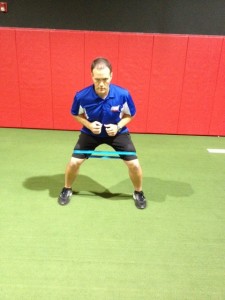Brian Schiff’s Blog
Injury Prevention, Sports Rehab & Performance Training Expert
In the majority of patients I see with knee pain or knee dysfunction, I uncover gluteal weakness and poor proximal muscular stability. This can cascade into overpronation, vagus collapse, poor balance, and any number of kinetic chain issues. While this may not be a big deal for sedentary individuals, it becomes a very big deal for athletes and those performing repetitive loading.
When searching for the best exercises to selectively strengthen the gluteal muscles, it is always wise to see what science has to say. More is not always better. I am all for efficiency and finding the most effective exercises in activating the glute over the tensor fascia lata (TFL). In this post, I am sharing a good exercise to do just that. Prior research has indicated that sidestepping and clamshells are very effective in doing just this. Click here to read a prior post on this.
The video below will walk you through his to do the running man exercise.
Click here to read my PFP column on this exercise.
Increasing hip strength and stability is a common focus in training and injury prevention programs. Current research indicates hip and knee strengthening is more effective than knee strengthening alone in those suffering from anterior knee pain. I routinely use mini-bands to strengthen the hips and maximize proximal stability.
Many clients struggle with poor proximal hip stability that shows up as excessive frontal plane adduction and compensatory trunk lean. This exercise targets the hips and closed chain control needed for those participating in jumping, running, cutting and pivoting activities. It is an excellent way to warm-up and activate the hips as well as reduce patellofemoral overload and prevent knee injuries.
Weakness in the gluteus maximus and gluteus medius is often cited in contributing to patellofemoral pain, IT band problems, hip pathology and even back pain. Furthermore, activating the glutes and minimizing tensor fascia lata (TFL) activation is preferential to avoid synergistic dominance with abduction exercises. This is a common finding on my clinical exams.

Photo from Myers
In the February 2013 issue of the Journal of Orthopaedic and Sports Physical Therapy (JOSPT), Selkowitz et al. examined several exercises to determine which ones had the highest gluteal-to-TFL muscle activation (GTA) index. The clam exercise proved to be the best with an index value of 115. The second highest exercise was a sidestep with elastic resistance with a value of 64.
The other three exercises to score a GTA index of 50 or higher were: Unilateral bridge (59), quadruped hip extension w/knee extended (50) and quadruped hip extension with knee flexed (50). Below is the clam executed against a wall as described in the study referenced.

Clam with resistance
Additional research done by Wilcox and Burden (published in the May issue of JOSPT) suggests that a neutral spine alignment and 60 degrees of hip flexion is the best position for gluteal activation during the clam. This study was done without resistance but offers additional insight to positioning. I try to mimic this hip flexion angle in the standing single and double leg versions I employ with mini-bands as part of my gluteal activation series in the clinic as well.

Single Leg ER (left)
In the Selkowitz study, participants performing the sidestep were instructed to step to the left replacing 50% of the distance between the feet in the start position and follow with the right leg also stepping at this 50% increment. This was then repeated to the right to return to the starting position for a total of 3 cycles.
This exercise has one of the lowest TFL activation and reinforces proper frontal plane mechanics and can be used with clients and athletes to reduce anterior knee pain and injury risk. To increase resistance and/or difficulty, bands can be moved to the ankles or a band can be applied above the knees and at the ankle. In my practice, I typically have clients sidestep for 10 yards in one direction (using the 50% rule) and then repeat moving back to the other side for 10 yards.

Sidestep
Another option is to perform the sidestep exercise with a staggered stance. For example, lead with the right leg forward moving to the right and vice versa. Again, small steps replacing 50% of the original stance is best to ensure quality work.

Staggered sidestep
For additional information on execution and application for these exercises, click on the links below for the online columns I wrote for Personal Fitness Professional Magazine:
Sidestep with elastic resistance
While I treat a vast number of knee ailments in my practice, the focus of my training and rehab is often more proximally directed at the hip. Understanding the role of hip muscles and how the hips and pelvis work together to impact knee alignment and closed chain function is critical in resolving knee pain and dysfunction.
Below is a “go to exercise” exercise I use for gluteus medius activation and core/pelvic stability training. Using a mini-band provides an adduction force cueing the client to abduct and activate their external rotators to maintain proper alignment. Additionally, they need to avoid a drop on one side of the pelvis (look at the ASIS).
Click here to read my entire column dedicated to this exercise in PFP’s online magazine. I hope you find this exercise and information useful for you and/or your clients.
Research has shown that strengthening the gluteus medius is clearly an essential way to reduce anterior knee pain and improve pelvic stability and function. The exercise I am sharing today is useful for improving hip strength and pelvic stability in a closed chain fashion.
In the video below, I demonstrate a very effective way to strengthen the gluteus medius and improve hip stability.
For a full description of the exercise, check out my latest column, Functionally Fit, by clicking here.

